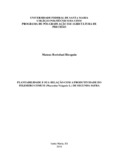| dc.creator | Bisognin, Mateus Bortoluzi | |
| dc.date.accessioned | 2018-11-12T20:06:22Z | |
| dc.date.available | 2018-11-12T20:06:22Z | |
| dc.date.issued | 2018-08-13 | |
| dc.identifier.uri | http://repositorio.ufsm.br/handle/1/14812 | |
| dc.description.abstract | Brazil is the third largest producer of beans in the world and the second largest consumer. The determination of the effect of different variation coefficients on the longitudinal distribution of seeds on the crop grain yield is essential, because the better plants are distributed in the sowing line, the less competition between them for water, light and nutrients. The objective of this study was to evaluate the productivity of a second harvest bean considering different coefficients of variation in the sowing line in an latosol conducted in a no - tillage system. The experiment was conducted in Jaboticaba / RS during 2017. The experimental design was a randomized block design, with four replications, and four variability levels were evaluated in the spatial distribution of seeds in the line, equivalent to 0, 20, 40 and 60% coefficient of variation (CV). The 0% CV treatment was equivalent to the desired uniform distribution of plants (10 plants per linear meter, spaced 10 cm apart). For the other treatments with errors in distribution (20, 40 and 60% of CV), the calculation departed through distances between predetermined plants, thus finding the due CV. Nine components of yield and crop grain yield were evaluated. The data were submitted to a variance analysis, by the F test, at a significance level of 5% and 1%. When the treatment was significant, polynomial regression analysis (p <0.05) was performed. Pearson's linear correlation analysis was also performed. The grain yield reduces linearly with the increase of CV in the distribution of bean seeds. For each 20% increase in CV of seed distribution there is a decrease of 163 kg ha-1 in grain yield. The component that best explains the CV effect of seed distribution on grain yield is the number of grains per plant (r = 0.94). Thus, a correct distribution of seeds in the sowing line should be recommended, and it has as consequence the increase of crop productivity and profitability. | eng |
| dc.language | por | por |
| dc.publisher | Universidade Federal de Santa Maria | por |
| dc.rights | Attribution-NonCommercial-NoDerivatives 4.0 International | * |
| dc.rights.uri | http://creativecommons.org/licenses/by-nc-nd/4.0/ | * |
| dc.subject | Distribuição longitudinal | por |
| dc.subject | Phaseolus vulgaris L. | por |
| dc.subject | Plantabilidade | por |
| dc.subject | Longitudinal distribution | eng |
| dc.subject | Plantability | eng |
| dc.title | Plantabilidade e sua relação com a produtividade do feijoeiro comum (Phaseolus Vulgaris L.) de segunda safra | por |
| dc.title.alternative | Plantability and its relation to the productivity of the common bean (Phaseolus Vulgaris L.) from a second harvest | eng |
| dc.type | Dissertação | por |
| dc.description.resumo | O Brasil é o terceiro maior produtor mundial de feijão e o segundo maior consumidor. A determinação do efeito de diferentes coeficientes de variação na distribuição longitudinal das sementes na produtividade de grãos das culturas é essencial, pois quanto melhor distribuídas as plantas na linha de semeadura, menor será a competição entre plantas por água, luz e nutrientes. O objetivo desse trabalho foi avaliar a produtividade de feijão segunda safra em função de diferentes coeficientes de variação na linha de semeadura em um Latossolo conduzido sob sistema de plantio direto. O experimento foi conduzido no município de Jaboticaba, RS durante o ano de 2017. O delineamento experimental foi o de blocos casualizados, com quatro repetições sendo avaliados quatro níveis de variabilidade na distribuição espacial de sementes na linha, equivalentes a 0, 20, 40 e 60% de coeficiente de variação (CV). O tratamento 0% de CV equivaleu à distribuição uniforme desejada das plantas (10 plantas por metro linear, espaçadas de 10 em 10 cm). Para os outros tratamentos com erro na distribuição (20, 40 e 60% de CV), o cálculo partiu através de distâncias entre plantas pré-determinadas, encontrando assim os devidos CV. Foram avaliados nove componentes do rendimento e a produtividade de grãos da cultura. Os dados foram submetidos à análise de variância, pelo teste F, ao nível de significância de 5% e 1%. Quando o tratamento foi significativo efetuou-se análise de regressão polinomial (p < 0.05). Realizou-se também, a análise de correlação linear de Pearson. A produtividade de grãos reduz linearmente com o aumento dos CV na distribuição das sementes do feijoeiro. Para cada 20% no aumento do CV na distribuição das sementes há um decréscimo de 163 kg ha-1 na produtividade de grãos. O componente que melhor explica o efeito do CV da distribuição das sementes na produtividade de grãos é o número de grãos por planta (r = 0,94). Dessa forma, uma correta distribuição das sementes na linha de semeadura deve ser preconizada e tem como consequência o aumento da produtividade da cultura e a rentabilidade da lavoura. | por |
| dc.contributor.advisor1 | Santi, Antônio Luis | |
| dc.contributor.advisor1Lattes | http://lattes.cnpq.br/6223011493102530 | por |
| dc.contributor.referee1 | Basso, Claudir José | |
| dc.contributor.referee1Lattes | http://lattes.cnpq.br/6844653805754593 | por |
| dc.contributor.referee2 | Vian, Andre Luis | |
| dc.contributor.referee2Lattes | http://lattes.cnpq.br/2593096345521125 | por |
| dc.creator.Lattes | http://lattes.cnpq.br/8574415304865242 | por |
| dc.publisher.country | Brasil | por |
| dc.publisher.department | Tecnologia em Agricultura de Precisão | por |
| dc.publisher.initials | UFSM | por |
| dc.publisher.program | Programa de Pós-Graduação em Agricultura de Precisão | por |
| dc.subject.cnpq | CNPQ::CIENCIAS AGRARIAS::AGRONOMIA | por |
| dc.publisher.unidade | Colégio Politécnico da UFSM | por |



